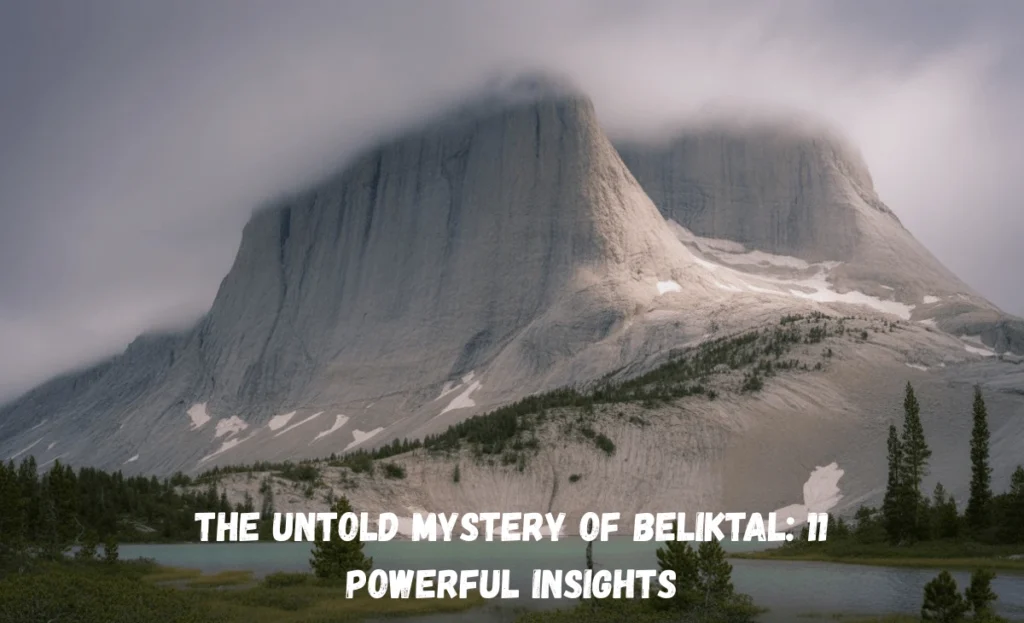Some names linger quietly in the corners of memory. Beliktal is one of them. Unfamiliar to most, yet deeply important to the few who still carry its weight in stories and ritual.
People often stumble across it in old books, carvings, or the words of elders. What they find isn’t a simple answer, but a deeper question.
So, what does it mean? Where did it come from? Why does it matter today?
Let’s explore.
What Is Beliktal, Really?
Scholars have tried to pin down its meaning. Yet, each attempt reveals just a piece of the puzzle.
The term seems to trace back to ancient mountain communities. They passed ideas through symbols and ceremonies, not writing. In their world, spoken language held power. Objects held memory. Patterns, like spirals or circles, told stories.
According to some interpretations, “beli” relates to what is unseen, and “ktal” may refer to a structure or form. Put together, the term suggests a hidden structure — maybe spiritual, maybe cultural, but always layered with meaning.
Cultural Threads That Carried It Forward
In isolated villages across vast plateaus, the tradition lived on.
Families wove it into textiles. Farmers offered it during harvest rituals. Children learned the name through bedtime tales whispered in dim huts.
It wasn’t just about belief. It shaped how communities lived, loved, and remembered. It gave identity to places that modern maps forgot.
Voices From the Past
Some elders speak of it as a guiding force. One elder, known simply as Korig, shared his thoughts during a rare interview.
“To forget beliktal,” he said, “is to forget your shadow.”
Others described it as a path. Not a physical one, but something internal — a way to feel grounded in times of change.
They didn’t just explain it. They sang it, drew it, and passed it down like a treasured heirloom.
Seen in Symbol and Song
Patterns on blankets. Songs sung during storms. Spirals carved into wood or stone.
These weren’t decorations. They were signposts. Reminders of values, stories, and seasons.
The image most often tied to the concept is a spiral. Not a perfect one, but flowing — like wind, or time.
Many believed the spiral helped guide souls, offer protection, or mark the beginning of important transitions.
Traces Left Behind Beliktal
Archaeological teams uncovered curious stone arrangements near the Alukh Range. These carvings, dating back over 3,000 years, matched symbols seen in surviving rituals.
Though no one can say for sure what the stones represented, nearby oral accounts spoke of rites involving sacred symbols that resembled what was found.
Clay items with similar designs turned up in valley settlements miles away. This suggests the belief once reached far beyond a single location.
Why It Started Fading
During the last century, pressures from colonial systems and centralized governments discouraged ancient practices. Many symbols, including this one, were seen as backward or irrelevant.
Stories went silent. Songs stopped being sung. Artifacts were tucked away or destroyed.
But memory is resilient. And some communities held on — even in whispers.
The Return of an Old Idea
Today, the symbol has resurfaced in unexpected places.
You might see it in folk art exhibits. In therapy sessions focused on ancestral healing. Even on jewelry inspired by lost traditions.
People are once again curious about roots. They’re reaching for stories that carry meaning — ones not shaped by marketing or algorithms.
That’s why the symbol matters again.
An Inner Language
One researcher described it as a “grammar of the heart.” Not meant for textbooks, but for moments of pause and reflection.
For many, it offers a language without words. A way to speak about grief, change, and hope when normal language fails.
No two communities saw it in exactly the same way. And that’s what makes it rich.
Not Just History
It’s tempting to see this as a relic — something gone. But talk to those who still carry the tradition, and you’ll hear something else.
It’s alive. Not in museums, but in songs. In tattoos. In the way some families still gather to tell stories on winter nights.
To call it outdated is to miss the point. It adapts. And it survives.
Lessons for the Present
In a world spinning fast, it offers slowness.
Not every answer needs to come from a screen. Not every truth has to be new. Sometimes, we just need to remember.
And that’s what this forgotten symbol helps us do.
What You Can Do
If the idea stirs something in you, don’t rush.
Start by listening — to music, stories, or people who remember old ways. Seek out community elders. Explore cultural centers. Learn with respect.
And don’t treat it like a trend. That’s not how tradition works.
One Field Visit I’ll Never Forget
In a remote hillside town, I met a woman named Mara. She was known for keeping old songs alive. When I asked about the ancient spiral pattern, she paused.
Then she said, “That’s the way my mother taught me to pray — in patterns.”
She sang a lullaby that echoed for hours afterward in my memory. It was simple, slow, and strong. That was the moment I understood: this was never about theory. It was about life.
FAQs about Beliktal
What does the term refer to?
It’s a cultural symbol linked to rituals, identity, and hidden meaning.
Where was it used?
Mainly in remote mountain villages across parts of Eurasia.
Is it still practiced today?
In some places, yes. Artists and healers also bring it into modern use.
Does it belong to a religion?
Not quite. It was part of community spirituality, not formal doctrine.
Why is it important now?
It helps people reconnect with their roots and with ideas deeper than modern noise.
Is there proof of its age?
Yes, through carvings, oral history, and archaeological finds.
Conclusion
This symbol, long buried under time and silence, has found its way back.
Not through force. But through quiet need. People are hungry for meaning. For story. For slowness. And in this pattern, they’re finding it.
So pause. Listen. Learn. And maybe, just maybe, the old stories will speak again — through you.






